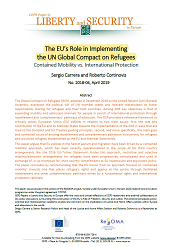The EU’s Role in Implementing the UN Global Compact on Refugees. Contained Mobility vs. International Protection
The EU’s Role in Implementing the UN Global Compact on Refugees. Contained Mobility vs. International Protection
Author(s): Roberto Cortinovis, Sergio Carrera
Subject(s): Politics / Political Sciences, Politics, Social Sciences, Law, Constitution, Jurisprudence, Human Rights and Humanitarian Law, Sociology, Migration Studies, EU-Approach / EU-Accession / EU-Development
Published by: CEPS Centre for European Policy Studies
Keywords: EU; UN Global Compact on Refugees; Contained Mobility vs. International Protection;
Summary/Abstract: The Global Compact on Refugees (GCR), adopted in December 2018 by the United Nations (UN) General Assembly, expresses the political will of UN member states and relevant stakeholders to foster responsibility sharing for refugees and their host countries. Among GCR key objectives is that ofexpanding mobility and admission channels for people in search of international protection through resettlement and ‘complementary’ pathways of admission. The GCR provides a reference framework to critically assess European Union (EU) policies in relation to two main issues: first, the role and contribution of the EU and its Member States towards the implementation of the GCR in ways that areloyal to the Compact and EU Treaties guiding principles; second, and more specifically, the main gaps and contested issues of existing resettlement and complementary admission instruments for refugeesand would-be refugees implemented at the EU and Member State levels.
Series: CEPS Papers in LIBERTY and SECURITY in Europe
- Print-ISBN-13: 978-94-6138-726-4
- Page Count: 26
- Publication Year: 2018
- Language: English
- eBook-PDF
- Table of Content
- Introduction

